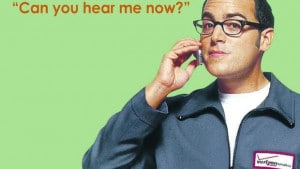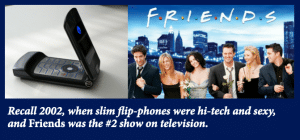
Let’s take the way-back machine all the way to 2002-ish. Those heady days of the wild-west internet and the mass popularization of the cell phone.
If you recall, back then unlimited plans were either unavailable, rare, or unaffordable.
 And although the late adopters were starting to jump on the cell phone bandwagon, they were not yet utterly ubiquitous.
And although the late adopters were starting to jump on the cell phone bandwagon, they were not yet utterly ubiquitous.
So the marketing was all about plans and price-per-minute-style competition. Even before number portability became a thing in 2003.
Or at least pricing wars was the order of the day for the likes of AT&T and Sprint and Cingular.
 ‘Cause that’s when Verizon decided on a different path.
‘Cause that’s when Verizon decided on a different path.
At the time Verizon was spending an estimated $1 billion every 90 days to improve service quality and to expand its coverage footprint.
So Verizon couldn’t afford to lower rates or compete on price.
Instead, they decided to out-compete AT&T and Sprint with better advertising.
They decided to advertise themselves as a premium cellular service provider — to advertise themselves as more reliable in more places.
And that’s when they rolled out this little gem of a campaign:
Did it work?
AND HOW!
- Verizon’s Net customers grew 10% to 32.5 million in the first year of the campaign
- Net Customers grew again by 15% to 37.5 million in the 2nd year.
- Customer churn dropped to 1.8% after two years, down from more than 2.5% before the campaign launched.
So what was so great about this campaign? What made it so effective?
Here are my 4 Major Takeaways:
It’s built on the truth
The campaigns now famous, horn-rimmed-glasses-wearing, ‘Test Man’ represented a real group of Verizon employees who each drove more than 100,000 miles every year to test the reliability of Verizon’s network. And Verizon really did have better coverage and a more reliable network.
It’s based on Customer Insight
Verizon knew that call connection reliability was becoming a key purchase consideration for wireless users. So they built their campaign about what actually mattered to the customer, and they did it so as to disqualify the (low-priced) competition at the same time. After all, if your call doesn’t go through — or gets dropped — then who cares how many minutes you have?
The Visuals Did Half the Work
 Half of the persuasion was that not only could Test Man always be heard, but that he could always be heard no matter where he was. So you see him poking his head out of man holes, walking through swamps and cornfields and deep deserts, and so on.
Half of the persuasion was that not only could Test Man always be heard, but that he could always be heard no matter where he was. So you see him poking his head out of man holes, walking through swamps and cornfields and deep deserts, and so on.
The idea of “Verizon has coverage EVERYWHERE” is visually dramatized as well as stated. The ads in this campaign harnessed the power of TV to create high impact.
It Used Ritual to Worm Its Way Into Your Brain
“Can you hear me now” — this is a phrase real people used to say all the time back in the earlier days of cell phones. Your connection would “cut out” due to spotty coverage and you’d ask “can you hear me now” before resuming the conversation.
Well, Verizon stole that and every time their “Test Man” asked it, he waited a beat and then said “Good.”
And this is a stroke of genius because the “yes” confirmation always occurs in your head. It’s never said on screen. You have to infer that Test Man got that confirmation. So the ads force you to imaginatively confirm that people can ALWAYS hear you on the Verizon network, no matter where you are.
This is why “Can you hear me now” is STILL associated with Verizon well over a decade after the campaign went off the air, and why that catchphrase has entered the pop-culture pantheon of advertising lines, joining the likes of “Where’s the beef” and “Whassup?”
How These Lessons Can Help Your Advertising
For starters, you’ll want to work with an ad agency that builds your campaign upon the truth.
And that means choosing an agency that’ll bother to spend enough time with you and your company that they CAN build a campaign tailored to your unique identity and values.
If your current agency doesn’t do this, fire them and hire someone who does.
Second, you’ll want to make sure your messaging speaks to things customers actually care about. The messaging has to move the needle on the “who gives a shit?” meter. Meaning that the messaging has to be based on sound strategy.
Third, work with a creative team that’s capable of harnessing the full power of your chosen media. If it’s radio, work with someone who understands the power of Theatre of the Mind and Parasocial Influence and storytelling. If it’s TV, work with someone who can dramatize your message visually.
And lastly, make sure your creatives know how to create ads that break through the clutter and capture the customer’s imagination.
Finally, if you’re starting to feel like you might need a new agency / ad guy, feel free to reach out if you’d like some help.
- Are You Paying for Too Much for the Wrong Keywords? - July 15, 2024
- Dominate Your Market Like Rolex — 4 Powerful Branding Lessons - July 3, 2024
- Military-Grade Persuasion for Your Branding - June 25, 2024
